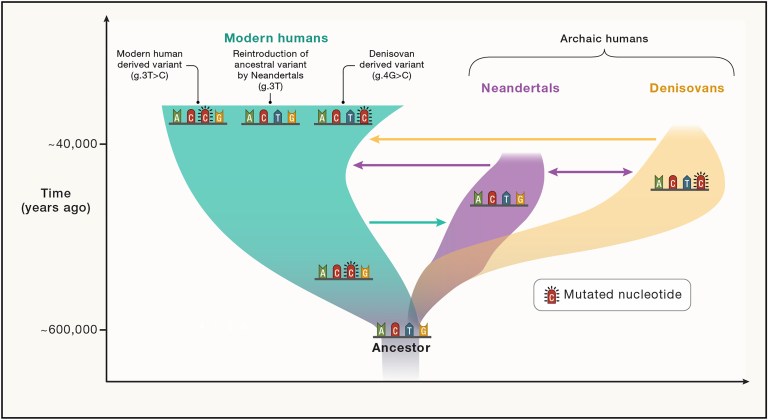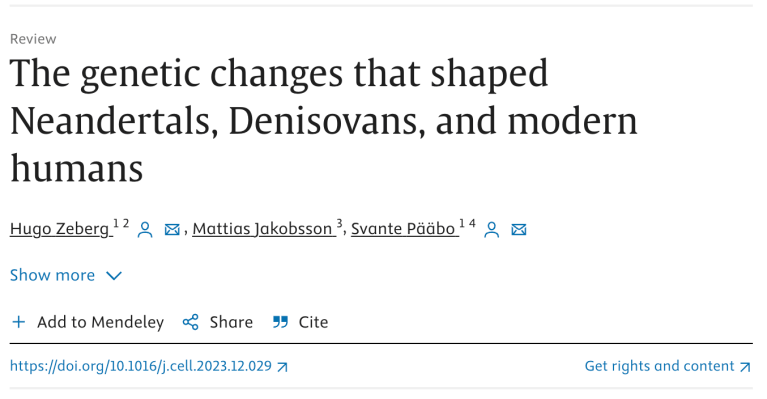Here’s a rare example of animal behavior being fossilized. In this case it’s in termites, whose modern representatives engage, as pairs, in a behavior called “tandem running”. This occurs after a group of reproductive termites who have left their natal nest fly away, a behavior certainly evolved as a way of staring new colonies. Unlike other social insects like bees, a termite colony contains both reproductive males and females, both of which have wings, eyes, and the capacity to mate and start new colonies (other workers lack wings and eyes). At mating time, a swarm of reproductive individuals fly away at random (they’re not good fliers), and then alight on the ground or, in the case at hand, on a tree trunk. After dropping their wings, they form mating pairs, each of which can start a new colony. To find that colony, a male and a female engage in “tandem running,” with (in the species below) the female running around with the male close behind, his head contacting her abdomen. Apparently some species can have either a male or a female as the leader in the tandem run. I can’t find out whether mating occurs before the tandem run or after the pair burrow into the ground to found their new colony.
When the female finds a site she likes, the pair digs in (most termites nest underground), and, after mating, the female becomes the “queen”, and the male the “king”. They remain monogamous, with the male continuing to fertilize the female throughout the life of the colony. This implies that all the termites in a colony are brothers and sisters. Since “kings” and “queens” can live for decades (25-50 years, according to one site, the colony can last a long time sending out reproductives to found new colonies.
At any rate, below you can see two examples of tandem running in reproductive alates (winged termites that have lost their wings). This is the behavior that appears to have been “fossilized”.
The YouTube notes:
When male and female termite alates (flying termites) pair up, they break off their wings and the male starts following the female around until she finds a suitable spot to start a new nest. This activity is called termite tandem running.
And so to the new paper in Proc. Nat. Acad. Sci. USA, which you can read by clicking on the title below or reading the pdf here.
The authors had a piece of 38-million-year-old Baltic amber, which is fossilized plant resin. (Baltic amber containing animal or plant inclusions like this can sell for a lot of money.) When resin or sap falls to the ground, it can, over long periods, be converted to amber by pressure and temperature of the sediments above. Eventually it becomes quite hard and can be mined.
In one pice of amber, the authors found two termites that looked as if they might have been tandem running when they got stuck in the sap and then preserved. Here’s a photo of their specimen, which is of the extinct species Electrotermis affinis. The caption to the partial figure below is “E. affinis pair in Baltic amber. (A and B) The dorsal and ventral sides of the tandem, respectively, with (B) an arrow pointing to the 15-articles antenna of the tandem leader.” The scale bars represent 0.5 mm.
This certainly looks like a tandem pair, but the problem is that they are not straight head-to-abdomen, but twisted a bit, so they are more side to side. Because it’s hard to get a good look at specimens in amber, and you can’t cut the amber open (that destroys the specimen), the authors used X-ray microtomography (a 3-D reconstruction using X rays) to show that the male is the one on the right in (A) and left in the ventral view (B); he’s smaller and the sexes can be told apart by the shape of the seventh “sternite”, or abdominal plate. They also saw that the female’s mouthparts were in contact with the tip of the male’s abdomen, which is what happens in tandem running. So we have a male and female in the right contact position, buttressing the idea that this is a tandem pair.
The authors then hypothesized that this was indeed a pair that was doing tandem running (probably on a tree) when they got stuck in sap, and the side-by-side position resulted from the pair trying to get unstuck. They failed, and eventually became part of a piece of amber.
To test this “position change” hypothesis, they put tandem-running termites of a living species, Coptotermes formosanus, in a sticky trap, a flat piece of cardboard covered with a sticky substance (I used them in the lab to catch cockroaches). This mimics a pair getting stuck in resin, and, as in resin, the pair could move around a bit after they got stuck. Would the tandem runners move more side by side?
Indeed they did. The stickiness led to the tandem pair shifting their positions as they tried to free themselves. In fact, they assumed a more side by side position once stuck. (I have to say that I find this experiment disturbing, as it involves killing insects for the sake of science. However, I killed cockroaches to keep my lab free of organisms other than fruit flies.)
Here’s what they found in 17 termites that didn’t escape the trap:
The spatial orientation of the leader and the follower after entrapment was significantly different than in natural tandem runs. The distance between the body centroids of the leader and the follower was smaller in trapped pairs than in natural tandems (Fig. 2 D–G and SI Appendix, Fig. S2, Exact Wilcoxon rank sum test, W = 599, P < 0.001). This is because partners of trapped pairs were often positioned side-by-side, differing from the linear positioning of natural tandems (Fig. 2 D–G). The shorter inter-individual distance could result from the two individuals entering the sticky surface together and becoming stuck near each other without the ability to move away, rather than their active behavioral interactions to maintain proximity.
And a picture of a living tandem pair (female in front) that wound up stuck more side by side, like the fossilized ones above:

They also concluded, from a complicated logistic regression, that the probability was 74% that the following individual was a female.
Finally, here’s a reconstruction in the paper of the original event that led to the fossil. Note that the “fossilized behavior” term is a bit incorrect, as what gets fossilized is not their normal behavior, but what seems to be the behavior of a tandemly running pair that’s gotten stuck. But given that there are individuals of both sexes in this pair, and that the antennae contact the abdomen, combined with what’s seen in the “resin mimicking” experiment, it’s seems likely that the authors are correct.

What about other examples of fossilized behavior? I want to put in a paragraph about this from the paper, just for your delectation:
Some fossils preserve the “frozen” behavior of animals in actions at the moment of death (9, 10). However, our results demonstrate that animals on the sticky trap are not instantaneously immobilized and change their postures on the surface. These experiments imply that the spatial orientation of animals preserved in sticky matrices, such as in tree resin prior to fossilization into amber, is influenced by the process of entrapment. Therefore, the interpretation of fossilized behavior can be dramatically refined or even corrected by observing the behavior of living organisms under entrapment conditions. Some behaviors fossilized in amber may remain unaltered by the entrapment process. For example, the preservation of mating moths in copula (14) or hell ants grasping prey items (12) suggests that the inter-individual interactions of these behaviors are strong enough not to be disturbed by the movement on the sticky surface. However, entrapment in amber likely affects many other behaviors. For example, insects dispersing through phoresy [attachment to other insects as a way of moving around] can be preserved detached from the host insect, perhaps because the host struggled on the sticky surface before complete encasement (37). The consequence of different behavioral responses can be studied using extant relatives. Furthermore, animals have evolved behavioral responses to sticky objects. For example, recent studies have revealed that ants are not passively affected by sticky objects but actively modify them. Red imported fire ants cover sticky surfaces with soil particles to access food resources (38), and granivorous desert ants remove sticky spider webs from nestmates to rescue them (39). Scavenging insects can be attracted by large animals trapped on a sticky surface (11, 35), and the spatial distribution of these insects may have reflected their foraging behavior. Thus, future studies on behavioral responses to sticky objects by animals will increase our understanding of fossil records in amber, as well as shed light on the behavioral capacity of extant insects.
I found it really interesting that ants can get around the danger of sticky substrates by covering them with soil, and can even remove spider web stuck to other ants. Ants have brains about the size of a grain of sand, but this behavior is somehow coded in there (or else they learn to do this, which seems less likely).
********
Reference: K. Mizumoto et al, 2024. Extinct and extant termites reveal the fidelity of behavior fossilization in amber. Proc. Nat. Acad. Sci. USA. https://www.pnas.org/doi/10.1073/pnas.2308922121























